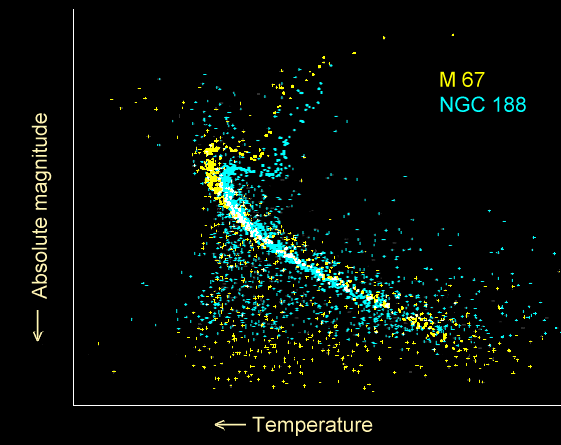main sequence turnoff on:
[Wikipedia]
[Google]
[Amazon]
 The turnoff point for a
The turnoff point for a
 The turnoff point for a
The turnoff point for a star
A star is a luminous spheroid of plasma (physics), plasma held together by Self-gravitation, self-gravity. The List of nearest stars and brown dwarfs, nearest star to Earth is the Sun. Many other stars are visible to the naked eye at night sk ...
refers to the point on the Hertzsprung–Russell diagram where it leaves the main sequence
In astronomy, the main sequence is a classification of stars which appear on plots of stellar color index, color versus absolute magnitude, brightness as a continuous and distinctive band. Stars on this band are known as main-sequence stars or d ...
after its main fuel is exhaustedthe main sequence turnoff.
By plotting the turnoff points of individual stars in a star cluster
A star cluster is a group of stars held together by self-gravitation. Two main types of star clusters can be distinguished: globular clusters, tight groups of ten thousand to millions of old stars which are gravitationally bound; and open cluster ...
one can estimate the cluster's age.
Stars with no turnoff point
Red dwarf
A red dwarf is the smallest kind of star on the main sequence. Red dwarfs are by far the most common type of fusing star in the Milky Way, at least in the neighborhood of the Sun. However, due to their low luminosity, individual red dwarfs are ...
s, also referred to as classM stars, are stars of . They have sufficient mass to sustain hydrogen
Hydrogen is a chemical element; it has chemical symbol, symbol H and atomic number 1. It is the lightest and abundance of the chemical elements, most abundant chemical element in the universe, constituting about 75% of all baryon, normal matter ...
-to-helium
Helium (from ) is a chemical element; it has chemical symbol, symbol He and atomic number 2. It is a colorless, odorless, non-toxic, inert gas, inert, monatomic gas and the first in the noble gas group in the periodic table. Its boiling point is ...
fusion via the proton–proton chain reaction, but they do not have sufficient mass to create the temperatures and pressures necessary to fuse helium into carbon
Carbon () is a chemical element; it has chemical symbol, symbol C and atomic number 6. It is nonmetallic and tetravalence, tetravalent—meaning that its atoms are able to form up to four covalent bonds due to its valence shell exhibiting 4 ...
, nitrogen
Nitrogen is a chemical element; it has Symbol (chemistry), symbol N and atomic number 7. Nitrogen is a Nonmetal (chemistry), nonmetal and the lightest member of pnictogen, group 15 of the periodic table, often called the Pnictogen, pnictogens. ...
or oxygen
Oxygen is a chemical element; it has chemical symbol, symbol O and atomic number 8. It is a member of the chalcogen group (periodic table), group in the periodic table, a highly reactivity (chemistry), reactive nonmetal (chemistry), non ...
(see CNO cycle
In astrophysics, the carbon–nitrogen–oxygen (CNO) cycle, sometimes called Bethe–Weizsäcker cycle, after Hans Albrecht Bethe and Carl Friedrich von Weizsäcker, is one of the two known sets of fusion reactions by which stars convert h ...
). However, all their hydrogen is available for fusion, and low temperature and pressure means a lifetime measured in trillions of years. For example, the lifespan of a star of 0.1 solar masses is six trillion years. This lifespan greatly exceeds the current age of the universe
The universe is all of space and time and their contents. It comprises all of existence, any fundamental interaction, physical process and physical constant, and therefore all forms of matter and energy, and the structures they form, from s ...
, therefore all red dwarfs are main sequence stars. Even though extremely long lived, those stars will eventually run out of fuel. Once all the available hydrogen has been fused stellar nucleosynthesis
In astrophysics, stellar nucleosynthesis is the creation of chemical elements by nuclear fusion reactions within stars. Stellar nucleosynthesis has occurred since the original creation of hydrogen, helium and lithium during the Big Bang. As a ...
stops, and the remaining helium slowly cools by radiation
In physics, radiation is the emission or transmission of energy in the form of waves or particles through space or a material medium. This includes:
* ''electromagnetic radiation'' consisting of photons, such as radio waves, microwaves, infr ...
. Gravity
In physics, gravity (), also known as gravitation or a gravitational interaction, is a fundamental interaction, a mutual attraction between all massive particles. On Earth, gravity takes a slightly different meaning: the observed force b ...
contracts the star until electron degeneracy pressure
In astrophysics and condensed matter physics, electron degeneracy pressure is a quantum mechanical effect critical to understanding the stability of white dwarf stars and metal solids. It is a manifestation of the more general phenomenon of quan ...
compensates and it goes off the main sequence, becoming a white dwarf
A white dwarf is a Compact star, stellar core remnant composed mostly of electron-degenerate matter. A white dwarf is very density, dense: in an Earth sized volume, it packs a mass that is comparable to the Sun. No nuclear fusion takes place i ...
.
References
Stellar evolution {{stellar-evolution-stub